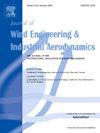Investigating low-frequency turbulence effects on building roof pressures through active flow control in a large boundary layer wind tunnel
IF 4.2
2区 工程技术
Q1 ENGINEERING, CIVIL
Journal of Wind Engineering and Industrial Aerodynamics
Pub Date : 2025-01-29
DOI:10.1016/j.jweia.2025.106009
引用次数: 0
Abstract
This study examines the effect of incident large-scale (low-frequency) turbulence on the wind pressure field acting on low-rise building roofs. Large-scale turbulence modulation was enabled by a high-performance 3 m × 6 m multi-fan array, termed Flow Field Modulator (FFM), situated at the upwind section of a large boundary layer wind tunnel (BLWT). The FFM was leveraged to actively generate low-frequency wind velocity fluctuations in the BLWT and operated in conjunction with a mechanized roughness element grid to simulate large- and small-scale turbulent atmospheric boundary layer flows. Aerodynamic pressure measurements were monitored on the surface of a 1:20 scale low-rise building model under multiple turbulent length scales and intensities. Experimental results demonstrate how, for similar turbulence intensity levels, higher correlation of pressure fluctuations in flow detachment zones are observed with increasing turbulent scales. Larger integral length scales were also linked to more pronounced non-Gaussian behavior (i.e., higher skewness) of local pressure signals in flow separation zones and along the path of conical vortices developed above the roof of the building model in the case of cornering wind azimuths. Finally, the study highlights how stronger non-Gaussian trends and increased pressure correlations lead to higher local and area-average peak suction roof loads.
在大型边界层风洞中通过主动流动控制研究低频湍流对建筑物屋顶压力的影响
本文研究了入射大尺度(低频)湍流对作用于低层建筑屋顶的风压场的影响。在大型边界层风洞(BLWT)的逆风段安装了一个高性能的3米× 6米多扇阵列,称为流场调制器(FFM),实现了大规模湍流调制。利用FFM在BLWT中主动产生低频风速波动,并与机械化粗糙度单元网格一起运行,以模拟大尺度和小尺度湍流大气边界层流动。在一个1:20比例的低层建筑模型表面进行了多种湍流长度尺度和强度下的气动压力监测。实验结果表明,在相似的湍流强度水平下,随着湍流规模的增加,流动分离区的压力波动具有更高的相关性。更大的积分长度尺度也与更明显的非高斯行为(即更高的偏度)有关,在流动分离区和沿建筑模型屋顶上方形成的锥形漩涡路径,在转角风方位角的情况下。最后,该研究强调了更强的非高斯趋势和增加的压力相关性如何导致更高的局部和区域平均峰值吸力屋顶荷载。
本文章由计算机程序翻译,如有差异,请以英文原文为准。
求助全文
约1分钟内获得全文
求助全文
来源期刊
CiteScore
8.90
自引率
22.90%
发文量
306
审稿时长
4.4 months
期刊介绍:
The objective of the journal is to provide a means for the publication and interchange of information, on an international basis, on all those aspects of wind engineering that are included in the activities of the International Association for Wind Engineering http://www.iawe.org/. These are: social and economic impact of wind effects; wind characteristics and structure, local wind environments, wind loads and structural response, diffusion, pollutant dispersion and matter transport, wind effects on building heat loss and ventilation, wind effects on transport systems, aerodynamic aspects of wind energy generation, and codification of wind effects.
Papers on these subjects describing full-scale measurements, wind-tunnel simulation studies, computational or theoretical methods are published, as well as papers dealing with the development of techniques and apparatus for wind engineering experiments.

 求助内容:
求助内容: 应助结果提醒方式:
应助结果提醒方式:


